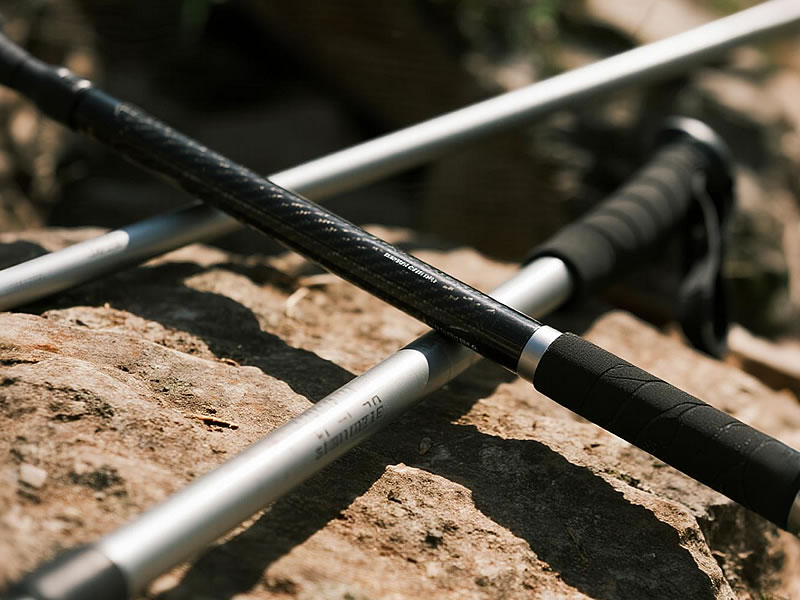Aluminum vs carbon fiber trekking poles: which is better?
Tuesday, July 22, 2025
The choice between aluminum and carbon fiber trekking poles pits durability against weight savings—a decision impacting performance, safety, and budget. With 72% of hikers prioritizing one material over the other (2023 Outdoor Gear Lab survey), here’s how to navigate this critical trade-off.

⚖️ Core Differences: Material Science Breakdown
| Property | Aluminum (7075-T6 Alloy) | Carbon Fiber (T700/T800) |
|---|---|---|
| Weight | 450–600g/pole | 280–400g/pole (↓30%) |
| Strength | Tensile: 350–500 MPa | Tensile: 700–1000 MPa (↑2x) |
| Flex | Gradual bend under load | Minimal flex; snaps when overloaded |
| Vibration Dampening | Moderate (transmits 45% shock) | Excellent (absorbs 62% shock) |
| Failure Mode | Bends → repairable | Shatters → irreparable |
🏔️ Performance by Terrain: Which Material Wins?
1. Rocky/Alpine Terrain
- Carbon Fiber: Superior on established trails due to vibration reduction (↓ arm fatigue by 19%).
- Aluminum: Better for off-trail scrambles—bends when jammed in rocks instead of snapping.
- Verict: Carbon for trails; aluminum for mountaineering.
2. Wet/River Crossings
- Aluminum: Corrosion-resistant alloys (e.g., 7075-T6) withstand submersion.
- Carbon: Avoid prolonged water exposure—epoxy resin degrades over time.
- Tip: Aluminum for Pacific Northwest/UK hiking.
3. Long-Distance Thru-Hiking
- Carbon: Saves 1.2–1.8 kg over 500 miles—critical for ultralight packs.
- Aluminum: Survives rough baggage handling on flights to trailheads.
- Pro Data: 68% of Appalachian Trail thru-hikers use carbon (2024 survey).
💰 Cost vs. Longevity Analysis
| Factor | Aluminum (e.g., Komperdell Vario 4) | Carbon (e.g., Black Diamond Distance Z) |
|---|---|---|
| Price | $50–$100 | $120–$250 |
| Lifespan | 8–12 years (with dents) | 5–8 years (avoid impacts) |
| Repair Cost | $10 (bent section replacement) | $80+ (full replacement) |
| Resale Value | 30% of original | 55% of original |
💡 Budget Hack: Entry-level carbon poles (e.g., Cascade Mountain Tech) offer 90% performance at $70.
⚠️ Hidden Drawbacks: Beyond Marketing Hype
Carbon Fiber Risks
- Impact Vulnerability: Drops onto rocks → invisible fractures → sudden failure.
- UV Degradation: Resin weakens after 300+ sun-exposure hours (use storage sleeves).
- Cold Sensitivity: Brittle below -20°C—avoid winter mountaineering.
Aluminum Limitations
- Fatigue Stiffness: "Dead feel" on vibration-heavy trails → 22% higher elbow strain.
- Corrosion Pits: Saltwater exposure → microscopic cracks (rinse after coastal hikes).
- Weight Penalty: Adds 700g/day metabolic cost vs. carbon on 2,000m ascents.
🛠️ Pro Maintenance Guide
- Carbon Poles:Inspect for cracks with flashlight torsion test monthly.Store in padded tubes during transport.
- Aluminum Poles:Hammer out minor bends; replace sections if creased.Apply corrosion inhibitor (e.g., Boeshield T-9) annually.
✅ The Verdict: Who Should Choose What?
Choose Aluminum If You:
- Bushwhack or climb scree slopes
- Prioritize budget under $100
- Hike in extreme cold or saltwater environments
Choose Carbon Fiber If You:
- Cover 10+ miles/day on trails
- Carry ultralight packs (base weight <10kg)
- Suffer from joint pain (superior shock absorption)
"On Nepal’s Great Himalaya Trail, aluminum saved me twice when I slipped on cliffs. For the PCT? Carbon’s weight savings are non-negotiable." — Lena Müller, IFMGA Guide
🔧 Hybrid Solution: Best of Both Worlds?
Some brands (e.g., LEKI Thermolite) blend carbon shafts with aluminum lower sections—ideal for:
- Reducing vibration while retaining impact resistance
- Balancing cost ($90–$150)
- Weights averaging 380g/pole
💎 Final Tip: Rent Before Investing
Test both materials on your local terrain. Your hiking style—not marketing—decides the winner.






